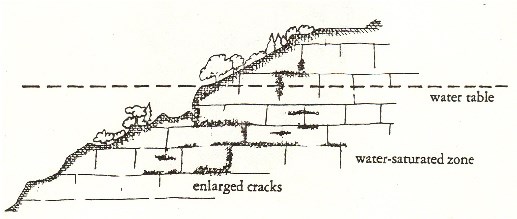
Over several million years, the belt of marble within the Siskiyou Mountain cracked as the land uplifted and folded. At the same time, the top of the mountain weathered and exposed the marble to the surface of the earth. A forest grew over the marble and in the forest soil, fungi, bacteria, and mold decomposed dead plants and animals releasing carbon dioxide. Precipitation percolated through the soil and captured the carbon dioxide to create carbonic acid. This mild acid is the same stuff that gives soda pop its fizz. The acidic water then chemically weathered the marble bedrock as it traveled downward through the cracks and holes in the rocks. Ground water moved downward until it reached the water table--an area where all available pore space in rocks are filled with water. The greatest amount of marble was dissolved just below the water table where the highest concentration of carbonic acid occurred. Water then spreads sideways along the cracks in the bedrock and the carbonic acid slowly dissolved the marble. Over hundreds of thousands of years, the carbonic acid enlarges small cracks into larger cavities as the marble was carried away (eroded) in solution. The process of dissolving marble and opening up spaces within it is called speleogenesis. Speleogensis is derived from the Greek words "spelaion" (cave) and "genesis" (beginning). |
Last updated: February 28, 2015
